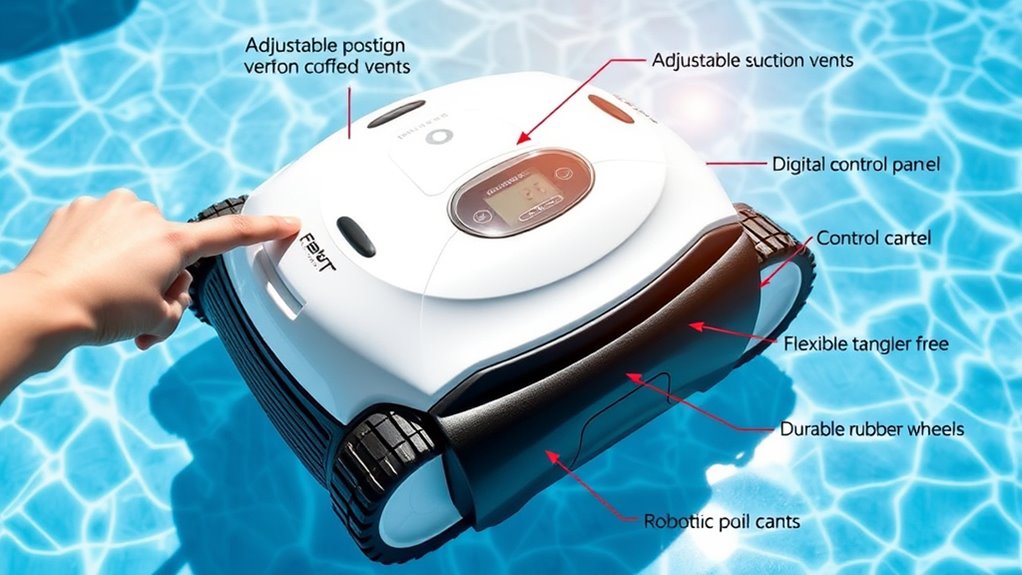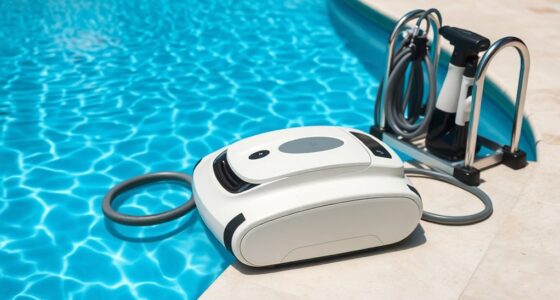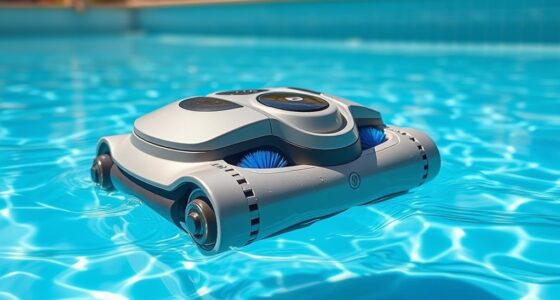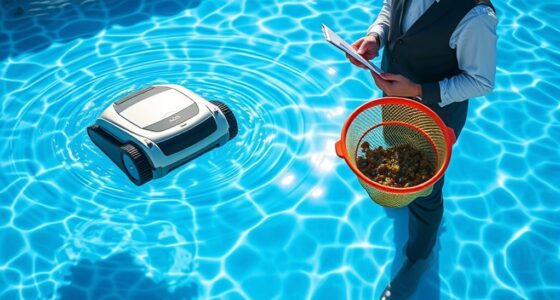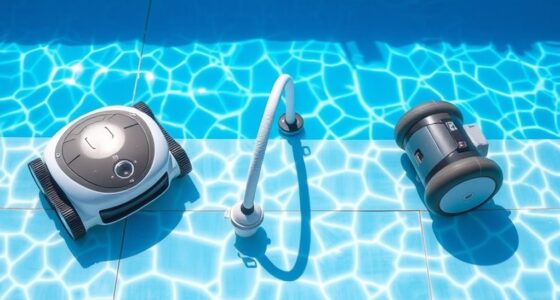When buying a robotic pool cleaner, consider if it fits your pool’s size, shape, and surface for effective cleaning. Check its features like filters, brushes, and navigation tech to verify thorough coverage. Look at energy use and how much power it consumes to save money long-term. Balance your budget with maintenance costs and reliability. Keep in mind that choosing the right model means investing in long-lasting performance—discover more tips as you explore your options.
Key Takeaways
- Ensure the cleaner fits your pool’s size, shape, and surface type for effective and comprehensive coverage.
- Check advanced navigation and filtering features for thorough cleaning and obstacle avoidance.
- Opt for energy-efficient models to reduce power consumption and operational costs over time.
- Balance initial cost with maintenance expenses, warranty coverage, and long-term durability for overall value.
- Consider ease of maintenance, reliability, and features that suit your specific pool configuration and cleaning needs.
Compatibility With Your Pool Size and Shape

When choosing a robotic pool cleaner, it’s vital to evaluate whether it fits your pool’s size and shape. Different models are designed for various pool surfaces, such as vinyl, fiberglass, or concrete, and some work better with specific pool types like in-ground or above-ground pools. Measure your pool’s dimensions accurately to guarantee the cleaner can cover the entire surface effectively. Larger pools require more powerful models with longer battery life and wider cleaning paths, while smaller pools fit more compact units. Consider the shape of your pool—irregular or curved pools may need a cleaner with customizable navigation. Matching the cleaner’s specifications to your pool’s surface and type ensures thorough cleaning without unnecessary features or limitations. Additionally, understanding the advancements in automation can help you select a model with smart features that adapt to your pool’s unique configuration. Incorporating appropriate size considerations can further optimize cleaning efficiency and ensure your pool remains pristine. Properly assessing your pool’s compatibility with cleaning tools can also prevent potential issues and improve overall maintenance. It’s also helpful to review the manufacturer’s recommendations to ensure compatibility and optimal performance.
Cleaning Capabilities and Features
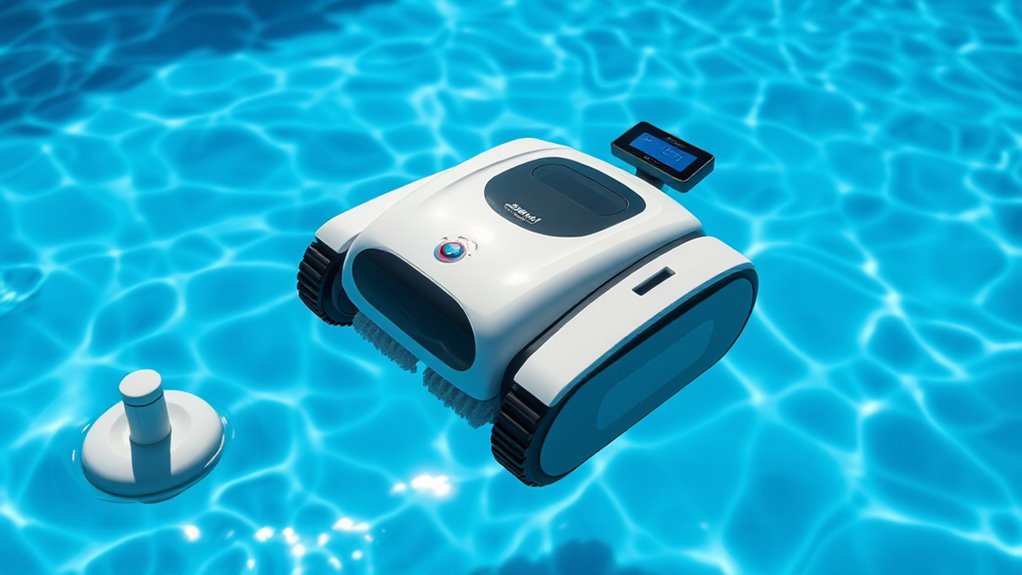
Understanding a robotic pool cleaner’s cleaning capabilities and features is vital to make certain it meets your needs. Look at the filter types it offers—whether it uses fine mesh, cartridge, or multi-layer filters—to guarantee it captures dirt, debris, and algae effectively. Consider the noise levels; quieter models make cleaning less disruptive, especially if you run them frequently or during peak hours. Advanced features like scrubbing brushes, programmable cleaning cycles, and adjustable suction power can enhance performance and customize cleaning to your pool’s specific requirements. Some cleaners also offer specialized modes for deep cleaning or targeting specific areas. Additionally, verifying the brand’s reputation and authenticity can help ensure you’re investing in a reliable product trustworthiness of Patchology. It’s also helpful to review user feedback on the effectiveness of eye patches to gauge how well the features perform in real-world scenarios. Being aware of the different filter types and their capabilities can significantly improve your understanding of how well a cleaner will perform. Modern robotic cleaners often incorporate AI-driven navigation, which allows for more efficient coverage of the entire pool and reduces cleaning time. Considering the performance of TDI engines can also give insight into the durability and efficiency of the motor components in some robotic cleaners. By evaluating these capabilities and features, you’ll select a model that efficiently keeps your pool sparkling and reduces maintenance time.
Navigation and Movement Technology
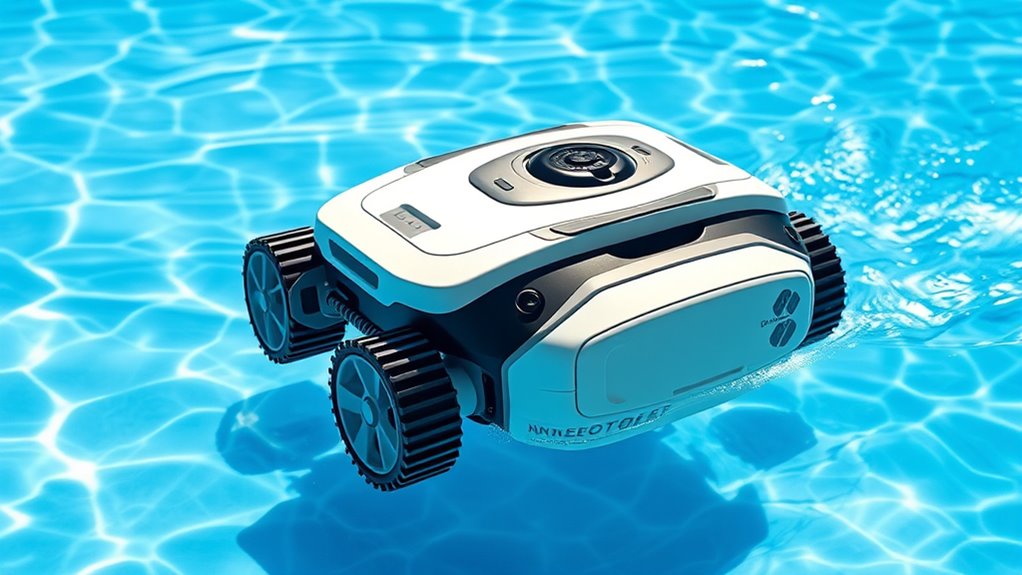
Navigation and movement technology determine how effectively your robotic pool cleaner covers every inch of your pool. Modern devices use advanced sensor technology and mapping systems to navigate efficiently. Here’s what to look for:
Advanced navigation ensures your robotic pool cleaner thoroughly covers every inch of your pool.
- Sensor Technology: Ensures the cleaner detects obstacles, walls, and pool features for precise movement.
- Mapping Systems: Create a virtual map of your pool, allowing systematic coverage and avoiding missed spots.
- Path Planning: Some cleaners use algorithm-driven routes, optimizing cleaning time and coverage.
- Navigation Modes: Options like random or systematic paths give you flexibility based on pool size and shape.
Choosing a model with reliable sensor technology and sophisticated mapping systems guarantees thorough cleaning and minimizes missed areas.
Energy Efficiency and Power Consumption
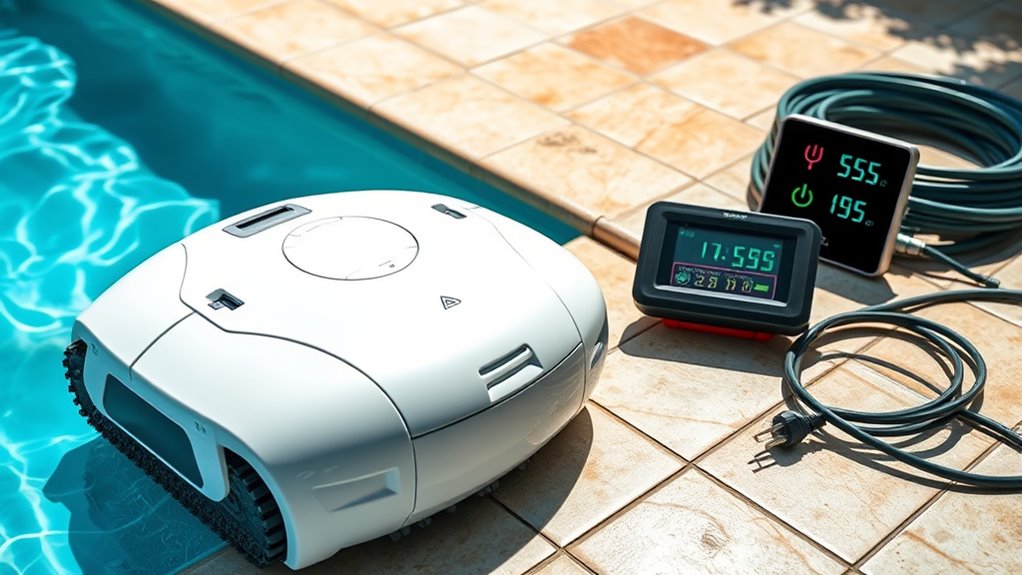
Energy efficiency and power consumption are crucial factors to factor in because they directly impact your long-term costs and the environmental footprint of your robotic pool cleaner. Choosing models that use less energy can save you money on electricity bills over time. Look for cleaners with features like solar power compatibility, which harnesses renewable energy and reduces reliance on traditional electricity sources. Additionally, consider noise levels, as quieter models tend to run more efficiently and provide a more pleasant experience while the cleaner operates. Efficient robots often have smart power management systems that optimize cleaning cycles, conserving energy without sacrificing performance. Prioritizing energy-efficient features ensures you get a cost-effective and eco-friendly pool cleaning solution. Moreover, selecting models with energy-efficient technology can further enhance savings and reduce environmental impact, especially when considering state tax implications which can affect overall operational costs. Incorporating models with advanced power management can lead to even greater energy savings and reduced carbon footprint, supporting sustainable living. Additionally, choosing energy-efficient models can contribute to environmental sustainability by lowering overall energy consumption and greenhouse gas emissions.
Budget and Maintenance Costs
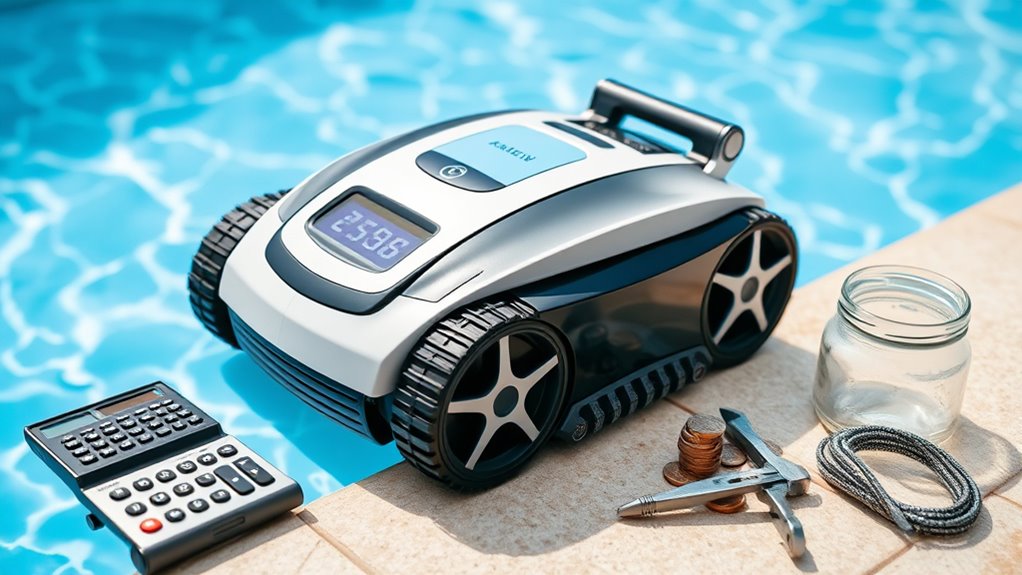
While energy efficiency helps lower ongoing costs, it’s also important to contemplate your initial budget and the ongoing expenses of maintaining a robotic pool cleaner. Conduct a thorough cost comparison to find models that fit your financial plan, considering both purchase price and long-term savings. Additionally, look into warranty coverage, which can save you money on repairs or replacements. Here are key points to consider:
- Initial purchase price versus features offered
- Maintenance costs like filter replacements or repairs
- Warranty length and coverage details
- Potential costs for accessories or upgrades
- Consider product reviews and customer feedback to gauge reliability and performance before making a decision. Remember that self-watering plant pots are designed to reduce maintenance efforts and promote healthier plants, which can be a helpful analogy when evaluating the ease of use and long-term reliability of pool cleaning devices. Furthermore, examining long-term operational costs can help you avoid unexpected expenses down the line. Incorporating drivetrain components and their durability considerations can also influence the overall cost-effectiveness of your pool cleaner. It’s also beneficial to review candy varieties and innovations to understand the importance of choosing durable and innovative products, which applies similarly to selecting a high-quality pool cleaner.
Balancing these factors ensures you choose a model that’s cost-effective not just upfront but over its lifespan, reducing unexpected expenses and ensuring reliable performance.
Frequently Asked Questions
How Long Do Robotic Pool Cleaners Typically Last?
Robotic pool cleaners usually last around 3 to 8 years, depending on how well you maintain them. Battery life plays a key role; high-quality units often have longer-lasting batteries. To extend their lifespan, you should follow recommended maintenance frequency, like cleaning filters and checking brushes regularly. Proper care guarantees you get the most out of your investment, keeping your cleaner functioning efficiently for years to come.
Are Robotic Pool Cleaners Safe for All Pool Types?
Think of your pool as a delicate dance floor, where safety is the rhythm you keep. Robotic pool cleaners generally adapt well, but you must consider pool safety and electrical hazards. Some models are designed for all pool types, including vinyl, concrete, or fiberglass, ensuring safe operation. Always check manufacturer guidelines to prevent electrical hazards, and opt for models with safety features that protect both your pool and loved ones.
Can Robotic Cleaners Handle Debris Like Leaves and Twigs?
Robotic pool cleaners are quite effective at handling debris like leaves and twigs. They excel in leaf management and twig removal, ensuring your pool stays clean. Many models come with strong suction and specialized brushes that pick up larger debris, saving you time and effort. Just make sure to select a robot with a powerful motor and good filtration, so it can tackle the debris without getting stuck or overwhelmed.
What Warranties Are Usually Available With Robotic Pool Cleaners?
Imagine your robotic pool cleaner as a trusted sidekick for your backyard oasis. Warranty coverage often acts like a shield, protecting you from future repair costs. Most models come with a one- or two-year warranty, and some offer extended plans. Reliable brands also provide repair services to keep your cleaner running smoothly. Knowing these protections helps you feel confident, ensuring your investment stays as sparkling as your pool.
Do Robotic Pool Cleaners Require Professional Installation?
Robotic pool cleaners usually don’t require professional setup, making installation fairly simple. The installation complexity is minimal, often just plug-and-play or connecting a few components. Most models come with clear instructions, so you can set them up yourself without needing professional help. However, if your pool has a complex system or unique features, consulting a professional might ensure maximum performance and safety.
Conclusion
Now, imagine your pool sparkling flawlessly, the water crystal clear and inviting. As you weigh your options, consider how each feature could transform your cleaning routine—saving time, energy, and effort. Will you choose a model that effortlessly navigates every corner or one that’s more budget-friendly? The right decision could be just a click away, but the choice is yours—are you ready to take the plunge and find that perfect robotic cleaner?
